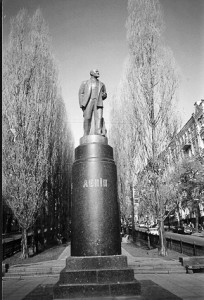I used to write quite a bit about the juvenile justice system, about how rehabilitation was a misnomer because the fact was the kids had never been given half a chance in the first place, that sort of thing. Back then I lived in Washington, D.C. All my clients were black. In Vermont nearly all my clients were white except one young black man whose marijuana charge we beat. A couple months later he called me up to tell me about the discrimination he’d experienced applying for a job. His story was pretty convincing, but as a public defender it wasn’t my job to take on cases like this on my own accord, so I referred him to the Attorney General’s office. I’ve felt bad about it ever since because he trusted me, and I somehow doubt he ever pursued the case any further, and it’s too bad because I suspect he had a legitimate grievance and it would have been interesting to bring such a case in a state that prides itself in being prejudice-free.
Since the cop killings of young black men in recent months the criminal justice system is under something of a microscope. (It’s about time) Former prosecutor Jeffrey Toobin wrote a piece in the New Yorker about the institutional bias of prosecutors. The New York Times ran an article about the unfairness of the bail system. When and where will it end? The sad fact is that we imprison far too many human beings and too many human beings of color in particular, and even if tomorrow we removed the rogue cops, addressed institutional bias in every prosecutor’s office in the nation, and “fixed” the bail system, it would only scratch the surface of the problem.
The criminal justice system is and perhaps always has been a war against the poor. Blacks, who are disproportionately poor in the U.S. are, therefore, hit by a double whammy. The fact is that few rich people go to jail in VT. I’m sure there are some, but anecdotally I never observed any while I was practicing. Was it because they had superior lawyers ? No doubt, that’s part of it, and of course if that’s the case, it’s a problem in its own right, but I think it’s more than just a matter of a lawyer’s skill. I’d argue that it’s a deep seated institutional bias that rich people don’t belong in jail (high profile exceptions only make the rule), poor people do.
*************************************************
Myth #1 Non-violent offenders are not sent to prison. This statement is not entirely false, but it is misleading. It’s true that first or even 2nd time nonviolent offenders are rarely sent directly to prison at the conclusion of their trial or plea deal; usually they are placed on probation. But probation is such that it is almost always possible for a probation officer to find some kind of technical violation and bring the probationer before the court for a revocation hearing that would send the probationer to prison. In fact this is the route by which nonviolent offenders usually find themselves in prison. It’s particularly disturbing when a probationer is waiting for an opening in a drug treatment or alcohol treatment program, and would be violated before even having a chance to enter the program. The idea that a person with a recognizable disease would be expected through pure willpower to overcome the disease, while waiting treatment, was, of course, absurd.
Myth #2 Drug courts mean that anyone who wants help with his or her drug problem will not be sent to prison. Governor Shumlin deserves great credit for highlighting the heroin problem in the state of Vermont, and he has certainly been a strong advocate of drug courts. I can only hope that the state of Vermont is well on its way to making myth #2 no longer a myth. All I can say is that there are drug courts and then there are drug courts. In the early days of drug courts in Vermont they were stingy and highly restrictive.
Myth #3 there are no innocent people in prison. Of course, no one really believes this anymore since the Innocence Project has managed to have so many death row inmates released through DNA evidence. The odd thing is that this hasn’t really filtered down to less serious felonies and misdemeanors in the public’s eye. In other words, if errors are made in high profile cases receiving a great deal of public scrutiny, imagine if you can how many errors are made in run of the mill cases receiving little to no public scrutiny.
How do innocent people end up in prison? Take a case where there is no physical evidence, and weak circumstantial evidence, an accuser and an accused. This leaves little before the jury but the issue of credibility. It’s more than likely that the jury will find one side more believable than the other, and even possible that the jury will find one side significantly more believable than the other. Yet how is it even theoretically possible for the accused to be be so lacking in credibility that the jury could find him or her guilty “beyond a reasonable doubt” with only a smidgeon of other evidence to go on? But it happens all the time. A lawyer might pick this hypothetical apart. The case should never have been brought to trial. The case should have been tried before a judge. The defense attorney was incompetent. Maybe, but certainly not in every case. The point is that the fear of crime has been so instilled in the public over the years that the very hard to meet standard of beyond a reasonable doubt has begun to erode, to more closely resemble the civil standard “more likely than not.” Of course the jury hears the judge mouth the words “beyond a reasonable doubt”, and even has it carefully explained, usually with hypotheticals. But does it really sink in? This is particularly true for certain crimes. There are crimes that offend us so much that it is quite natural to identify with the alleged victim. The public thinks why would he or she make it up? Or their visceral fear of seeing a wrong going unpunished outweighs their fear of making a mistake
At the end of the day we might just find that the problem with the criminal justice system is not just rogue cops, institutional bias through the criminal justice system, and shortsighted government spending decisions, but us.
What if anything does all this have to do with East European Diaries? Some might be inclined to say not very much, but for those inclined to read between the lines I’d suggest that’s not necessarily true.

